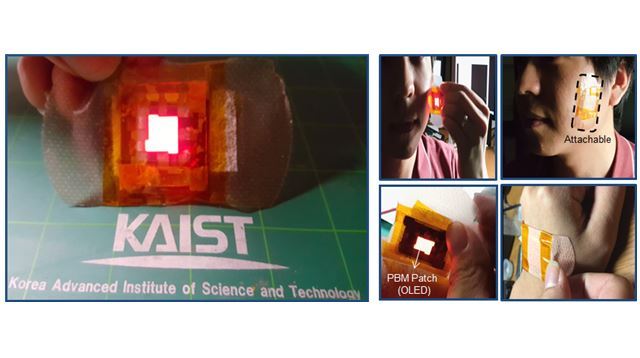A team of South Korean researchers developed an “OLED patch” that can be attached to the skin to help wounds heal using an organic light-emitting diode source aimed at damaged areas.
The technology was developed by a group of researchers led by KAIST’s Jeon Yong-min and Seoul National University Bundang Hospital’s Choi Hye-ryung.
The finding were published in the academic journal Advanced Material Technologies on March 8.
 |
Prototypes of the OLED patch developed by the team of Korean researchers from KAIST and Seoul National University Bundang Hospital (National Research Foundation of Korea) |
The OLED patch has been designed as an easy, portable tool for delivering a technique called photobiomodulation. PBM is a form of light therapy that uses lasers or light-emitting diodes to improve tissue repair as well as reduce pain and inflammation.
PBM has long been considered a safe and noninvasive method of instigating tissue regeneration. Yet, conventional PBM devices using pointed light sources, such as light-emitting diodes and lasers have key shortcomings, including low flexibility, heavy weight and uneven applications.
Overcoming such disadvantages, the Korean research team developed a wearable PBM patch using a “flexible red-wavelength OLED surface light source, which can be attached to the human body,” according to the research paper.
The OLED patch is palm-sized, lightweight, flexible and durable. It weighs 0.82 grams and has a thickness of just 676 micrometers. The patch can operate for more than 300 hours, and is able to bend along a curve with a 20 millimeter radius.
Its temperature also remains below 40 degrees Celsius at all times, removing risks of a first-degree burn.
Given the design, the light therapy patch can be worn on the skin comfortably, allowing patients to receive constant treatment daily without much discomfort, according to developers.
The Korean research team has proven through experiments that the OLED patches can help heal wounds by stimulating the proliferation and migration of fibroblast, a type of dermal cells that play a key role in the wound healing process.
The OLED patch was shown to increase fibroblast proliferation by 58 percent, and fibroblast migration by 46 percent, proving its effectiveness in tissue regeneration, according to the team.
“Once commercialized, our patch will enable patients to receive light therapy conveniently,” said the paper’s lead author Jeon via the National Research Foundation of Korea.
“By controlling the amount of the emitted light, we can also extend the product’s use to include not just skin regeneration, but also treating conditions like skin cancer, Alzheimer’s disease and depression.”
This research was sponsored by a basic research support program led by Korea’s Ministry of Science and ICT.
By Sohn Ji-young (
jys@heraldcorp.com)








